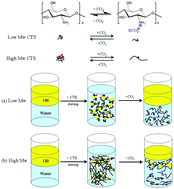The effect of chitosan molecular weight on CO2-triggered switching between emulsification and demulsification†
Abstract
The role of molecular weight as a key physical property of macromolecules in determining the CO2-triggered switching characteristics of responsive emulsions prepared using CO2-switchable macromolecules has not been studied and is the focus of the current study. In this work, CO2-switchable chitosan of four different molecular weights is used to investigate the effect of molecular weight on CO2-triggered switching of CO2-responsive emulsions. The molecular weight of chitosan is shown to have an opposite effect on emulsification and demulsification by the CO2 trigger. Before bubbling of CO2, chitosan of higher molecular weight forms a more stable three-dimensional network structure in the continuous phase of oil-in-water (O/W) emulsions, which leads to the formation of a more stable emulsion. After bubbling of CO2, the chitosan of higher molecular weight makes the continuous phase more viscous, which leads to an incomplete demulsification as compared with the chitosan of lower molecular weight. Experimental evidence from the measurement of conductivity, interfacial tension and rheological properties is provided to support the proposed mechanism. This work is of great significance in guiding the selection of desirable CO2-switchable polymers for switchable emulsions of desired switching characteristics.



 Please wait while we load your content...
Please wait while we load your content...